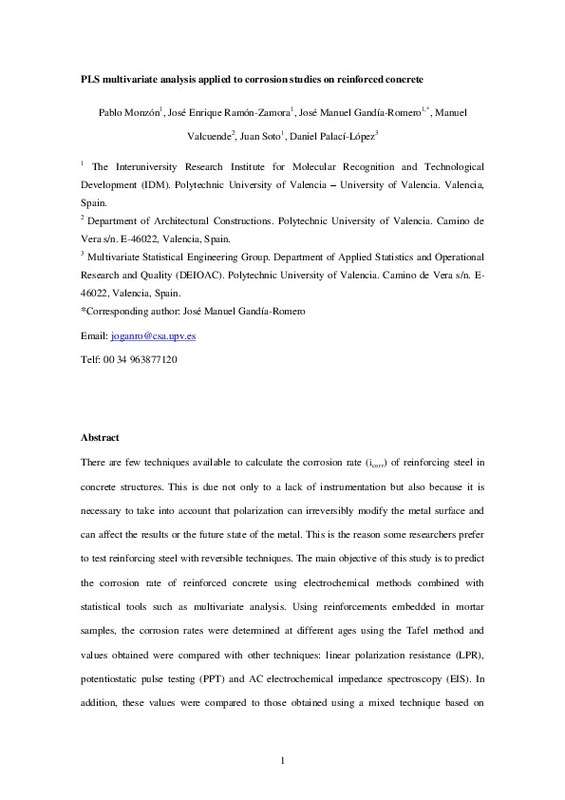Chang, Z.-T., Cherry, B., & Marosszeky, M. (2008). Polarisation behaviour of steel bar samples in concrete in seawater. Part 1: Experimental measurement of polarisation curves of steel in concrete. Corrosion Science, 50(2), 357-364. doi:10.1016/j.corsci.2007.08.009
Law, D. W., Millard, S. G., & Bungey, J. H. (2000). Linear polarisation resistance measurements using a potentiostatically controlled guard ring. NDT & E International, 33(1), 15-21. doi:10.1016/s0963-8695(99)00015-8
Andrade, C., & Alonso, C. (1996). Corrosion rate monitoring in the laboratory and on-site. Construction and Building Materials, 10(5), 315-328. doi:10.1016/0950-0618(95)00044-5
[+]
Chang, Z.-T., Cherry, B., & Marosszeky, M. (2008). Polarisation behaviour of steel bar samples in concrete in seawater. Part 1: Experimental measurement of polarisation curves of steel in concrete. Corrosion Science, 50(2), 357-364. doi:10.1016/j.corsci.2007.08.009
Law, D. W., Millard, S. G., & Bungey, J. H. (2000). Linear polarisation resistance measurements using a potentiostatically controlled guard ring. NDT & E International, 33(1), 15-21. doi:10.1016/s0963-8695(99)00015-8
Andrade, C., & Alonso, C. (1996). Corrosion rate monitoring in the laboratory and on-site. Construction and Building Materials, 10(5), 315-328. doi:10.1016/0950-0618(95)00044-5
Glass, G. K., Page, C. L., Short, N. R., & Zhang, J.-Z. (1997). The analysis of potentiostatic transients applied to the corrosion of steel in concrete. Corrosion Science, 39(9), 1657-1663. doi:10.1016/s0010-938x(97)00071-1
Poursaee, A. (2010). Potentiostatic transient technique, a simple approach to estimate the corrosion current density and Stern–Geary constant of reinforcing steel in concrete. Cement and Concrete Research, 40(9), 1451-1458. doi:10.1016/j.cemconres.2010.04.006
Bastidas, D. M., González, J. A., Feliu, S., Cobo, A., & Miranda, J. M. (2007). A Quantitative Study of Concrete-Embedded Steel Corrosion Using Potentiostatic Pulses. CORROSION, 63(12), 1094-1100. doi:10.5006/1.3278327
Saricimen, H., Mohammad, M., Quddus, A., Shameem, M., & Barry, M. . (2002). Effectiveness of concrete inhibitors in retarding rebar corrosion. Cement and Concrete Composites, 24(1), 89-100. doi:10.1016/s0958-9465(01)00030-0
Lee JLS Gilmore IS Seah MP Extract of multivariate analysis terminology from ISO 18115-1 Surface Chemical Analysis - Vocabulary - Part 1: general terms and terms for the spectroscopies National Physical Laboratory. Teddington. Middlesex UK 2010
UNE 112072: Determinación de la velocidad de corrosión de armaduras en laboratorio mediante medidas de la resistencia de polarización 2001
ASTM G 102-89: Standard pratice for calculation of corrosion rates and related information from electrochemical measurements 2010
Trabanelli, G., Monticelli, C., Grassi, V., & Frignani, A. (2005). Electrochemical study on inhibitors of rebar corrosion in carbonated concrete. Cement and Concrete Research, 35(9), 1804-1813. doi:10.1016/j.cemconres.2004.12.010
Koleva, D. A., de Wit, J. H. W., van Breugel, K., Lodhi, Z. F., & van Westing, E. (2007). Investigation of Corrosion and Cathodic Protection in Reinforced Concrete. Journal of The Electrochemical Society, 154(4), P52. doi:10.1149/1.2436609
Stern, M., & Geaby, A. L. (1957). Electrochemical Polarization. Journal of The Electrochemical Society, 104(1), 56. doi:10.1149/1.2428496
McCafferty, E. (2005). Validation of corrosion rates measured by the Tafel extrapolation method. Corrosion Science, 47(12), 3202-3215. doi:10.1016/j.corsci.2005.05.046
Poorqasemi, E., Abootalebi, O., Peikari, M., & Haqdar, F. (2009). Investigating accuracy of the Tafel extrapolation method in HCl solutions. Corrosion Science, 51(5), 1043-1054. doi:10.1016/j.corsci.2009.03.001
[-]







![[Cerrado]](/themes/UPV/images/candado.png)


